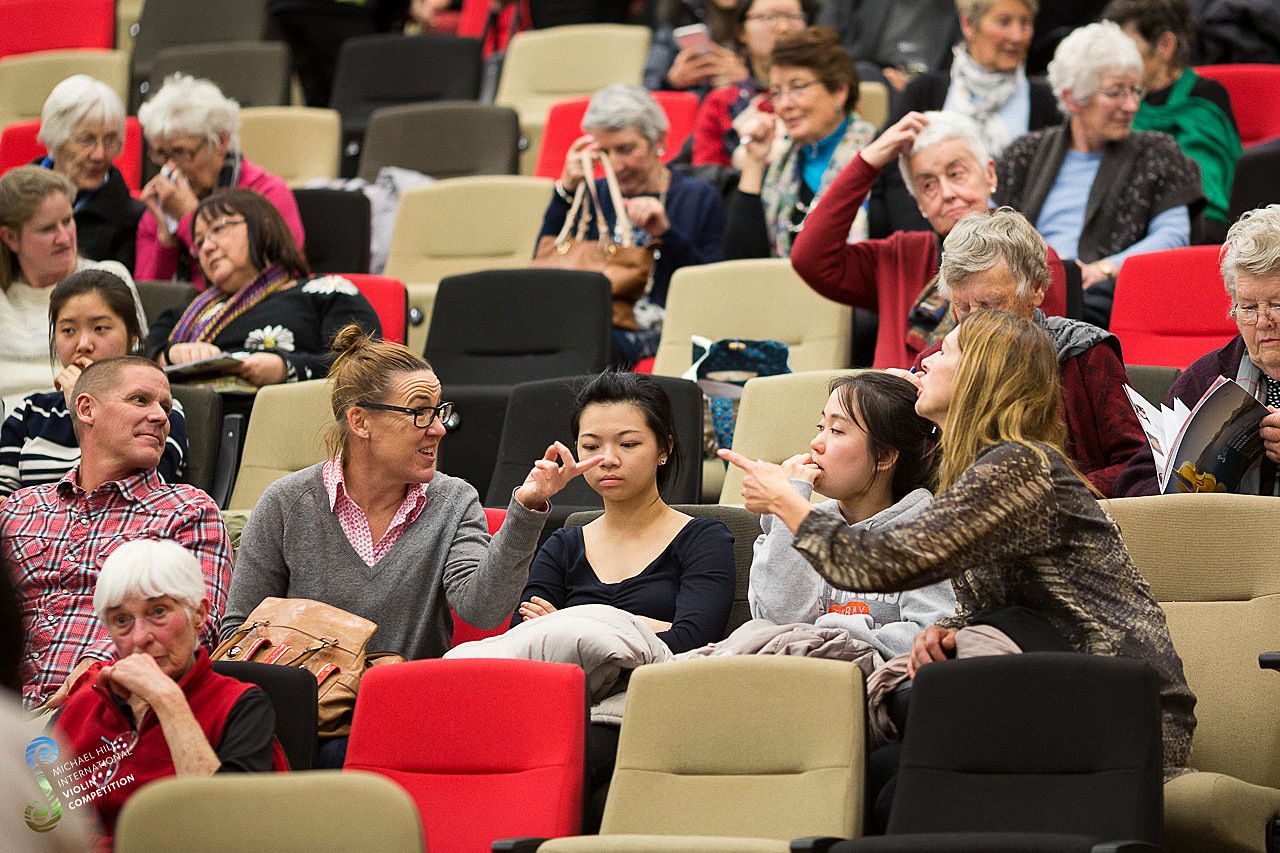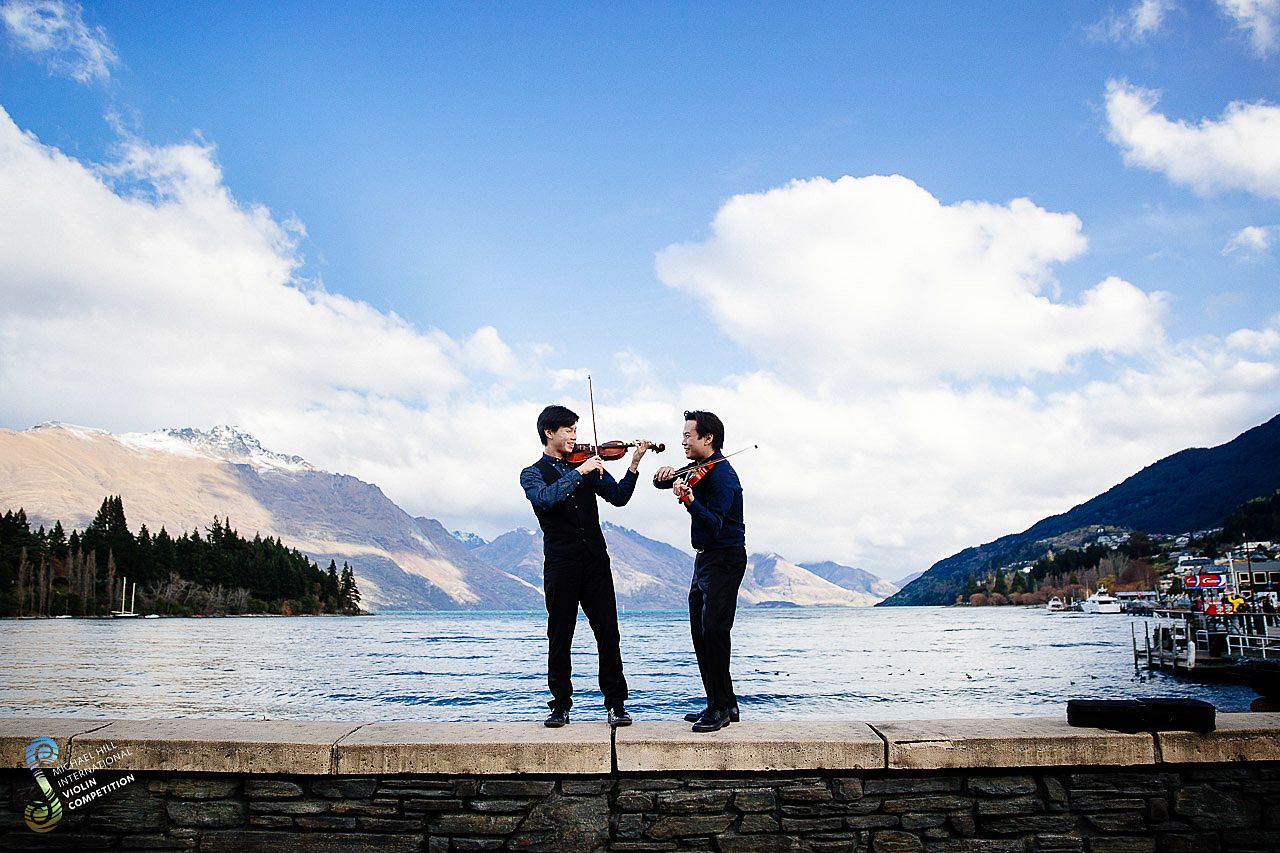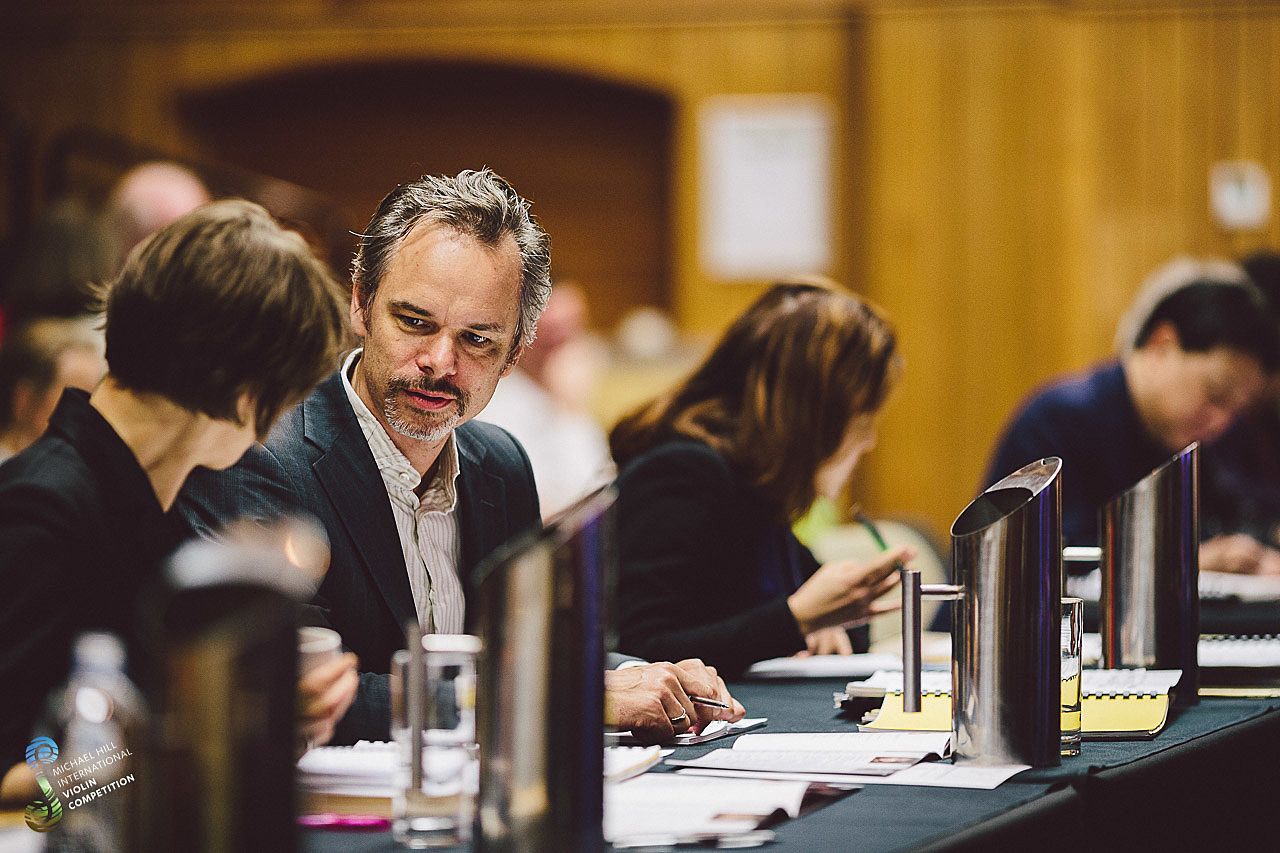High Stakes and The Armchair Listener: the 2015 Michael Hill International Violin Competition
Competitions are for horses, not for artists.
– Bela Bartok
It’s 9:30am and anticipation laces Queenstown’s atmosphere with static electricity.
Inside the city’s refurbished memorial hall the audience fusses about, shedding coats and scarves, collecting cups of tea from the kitchen, choosing seats, waving to companions, flicking through the programme and finding pens. Gossip spreads through the crowd: “Timothy Chooi is one to watch–his brother won first prize at the last competition,” and “Look! There’s Sir Michael Hill in the front row,” and "If one competitor was playing a Stradivarius, and another a modern instrument, do you think we could tell the difference?" And “Did you know? Half the judges almost didn’t make it because the weather stuffed up the flights!”
The Michael Hill International Violin Competition has developed a reputation for attracting competitors of exceptional calibre. For those who enjoy violin music, the competition offers a chance to glut oneself on a feast of exquisite musical performances. Eighteen semi-finalists are winnowed from 158 entries from around the world. After two rounds in Queenstown, six competitors progress to round three in Auckland, and finally the last three competitors proceed to the grand final in Auckland Town Hall. The stakes? $40,000, a recording contract, and a concert tour around New Zealand the following year.
It’s a prize designed to launch the career of a young violinist and it’s hotly contested. But how do the judges decide? How can you choose between jasmine and rose? Between the ocean and a spa bath? Between an intimate performance and a bold one? How can we effectively rank works of art, particularly ones as ephemeral as musical performances?
And setting those questions aside for a moment, why are we so attracted to competitions in the first place? Are we addicted to spectatorship? We love to see athletes, musicians and artists testing the boundaries of what’s possible, performing feats that we could never hope to accomplish as we judge them from the safety of our seats. But perhaps this paints too grim a picture. Observing excellence can be inspirational, and many audience members come simply for an outstanding musical experience.
The challenge is to prevent ourselves from becoming passive consumers. An excellent performance should change us a little. Whether it’s that we leave with a small corner of peace in our soul, or our energy is recharged, or our brain starts down a new path or we go home and sing made-up songs with our children, we ought to be changed somehow. Otherwise we simply ossify, growing fat on indulgent experiences.
It’s not only the performative aspect that draws audiences to the competition though, it’s the community that exists around it. The competition’s a magnet for music lovers, with professional and amateur violinists, teachers and students, people who love violin music, string players of all kinds, and the movers and shakers in the arts world all congregating. Everyone talks to everyone else, sharing their opinions on the competitors and their performances, comparing their personal favourites. Despite occasional disagreements, the sense of camaraderie cultivated by the competition is hugely attractive.
Audience members often also gain a sense of personal investment in the competition outcome, championing their particular favourites. Choosing a favourite usually encompasses more than just the musical elements of the performance. After hearing the same sets of repertoire in the same order throughout the morning, it’s hard not to look favourably on a violinist who chooses to play the material in a different order to the default, or to applaud the woman who challenges tradition by rocking sparkly jeans and a lace tunic rather than a gown. The judges are expected to base their decisions solely on the musical quality of the performances, but the audience seeks a personal connection with the competitors and relishes these hints of individuality. After forming allegiances to certain players in the early rounds, audience members feel personally victorious when ‘their’ players make it through to the next round, or aggrieved and shocked if they don’t.
Risk is another drawcard. The stakes are high, and there can only be one winner. Competitions carry an inherent excitement, and with violinists attempting outrageously difficult pieces, there's always the chance that they won’t pull it off. Paganini's 24th Caprice is a variation movement, with each variation being successively harder. Many violinists can manage the first variations, but far fewer can pull off the final variations successfully. When a competitor chooses to perform this particular caprice I spend the whole performance in suspense, willing them to succeed but terrified they’ll fail. The competition environment is a great place to get your adrenalin hit, but without any personal risk.
It’s worth mentioning that dramatic mishaps do not necessarily affect the competitor’s overall result. One missed note isn’t really a big deal if the rest of the performance is secure. For example, I’m convinced that there was a moment in the first-prize-winner’s concerto performance where she had a memory lapse for half a second, but nobody cared, because she jumped straight back into the flow of the music and the rest of her performance was so convincing. Slips become an issue when they mar the overall communication of the performance, distracting from the musician’s efforts to give meaning to a series of notes.
As is standard in violin competitions, the competitors had to perform music from a wide range of styles and genres. Music by an early composer like Bach, who wrote for an instrument with gut strings, a shorter neck, and a differently shaped bow, requires a very different skill-set to playing music by Janáček, who wrote for the instrument in it’s modern incarnation. The greater tension and more brilliant sound permitted by synthetic strings allows the music to be ripped from the violin with terrible ferocity. Music for solo violin, where the violinist is exclusively in charge of the sound world, requires different communicative abilities to a violin sonata, in which the violin and piano work together to create one whole. In it’s primary sense, ‘communication’ refers to the ability of the performer to convey an idea, impression or sense of meaning to the audience, but in the context of two or more musicians on stage, it can also encompass the gestural cues musicians use to coordinate their parts as well as the performer’s ability to maintain a wider awareness of what the other musicians are doing and adapt their own performance as required. In a showpiece, the violinist has to battle the technical hurdles, careening all over the violin and pulling every crowd-pleasing trick out of the hat, but still creating some kind of musical continuity; in a salon piece, conversely, the violinist must charm with a minimum of musical material. Requiring violinists to perform such a wide repertoire is effective for identifying a well-rounded violinist, but it does sometimes mean that the musician who gives the most outstanding performance in one area may not necessarily do well overall in the competition.
Drawing comparisons between the performances is inevitable; my programme book is covered with scribblings about each player. As audience members, we can feel a little guilty for simply sitting and absorbing while the musicians are working phenomenally hard on stage. We seek some way to assert agency over our experience, not just to be passive listeners, and so we assess and evaluate the performances we hear.
How do we do that? Firstly, a successful performance needs to be technically secure, with the overall communication overriding any minor flaws. But when faced with an array of competent performances, one way to evaluate them is to embrace the subjectivity of the experience, and rank candidates according to what one personally values in a performance. Personally, I admire violinists who can make a big sound, who present a wide variety of tone colours, and who can show me something new about a piece I’ve heard before, so I put those players to the top of my list, over players who can make a gorgeous sound, but only a gorgeous sound, or players who have a solid technique but no spark to their playing. Of course the problem is that other perspectives may and do exist.
Are there elements of violin playing that can only be appreciated or understood by other violinists or musicians? Perhaps. However many of the untrained listeners at the competition expressed preferences for competitors that I wouldn’t have voted for, but the judges did. Musical training (or lack of it) doesn’t necessarily have a bearing on the accuracy expressed opinions; judge Helene Pohl comments that a mark of an excellent performance is that it communicates with listeners of all backgrounds: "It's one thing to showcase the music's greatness, but it's another to ensure the audience really feels connected to its essential message, whether they’re experienced listeners or not."
On the other hand, having the technical vocabulary and first-hand understanding of the difficulties the competitors face can be a huge advantage when you’re trying to rank them. While the average listener may only hear the final product, judges, as informed listeners, have the skills and knowledge to hear the intricate network of choices and challenges behind each performance.
This year’s first prize winner, Australian Suyeon Kang, also won the audience prize, but that doesn’t happen every time. The lack of unanimous agreement on a preferred competitor returns us to the question of how we select a winner when everyone reacts to music differently, and a range of opinions can legitimately exist.
This particular competition approaches the problem by taking the majority of a set of informed opinions. The competition was judged by a panel of seven international violinists, carefully drawn from disparate disciplines including concert soloists, pedagogues, recording artists and chamber musicians. Progressing or winning competitors needed a majority vote from the judges. However, the judges weren’t permitted to discuss the competitors with each other, so decisions are made within the privacy of each judge’s own mind, and then by anonymous voting procedure.
Even the judges will readily acknowledge there’s a level of subjectivity in the evaluation of a musical performance. Judge Susie Park sums up what she looks for: "Technical proficiency and inherent musicality are perhaps two of the more obvious attributes the winner might have. A compelling communicator with a unique voice that I want to hear again is what will stand out for me." Technique, musicianship and communication are the trinity of musical criteria used for judging as early as grade one violin exams, yet even these criteria contain obvious inherent subjectivity. What ‘communicates’ and is meaningful to one person may not communicate to another.
One way to reduce the difficulty of comparing performers is to have them play similar material, and the competition had obviously considered this in the repertoire that they set for each round. While the violinists each had a certain amount of choice in the repertoire that they presented, they generally had to choose from within a prescribed set of musical works. In some sections there was no choice offered, with all performers required to play the same work. In this way, the competition sought to identify an outstanding, well-rounded violinist.
Knowing I was going to hear a lot of the same or similar repertoire, I was worried I’d encounter clone-like performances. Classical music very much prizes the ability to play ‘the dots on the page,’ and the internet means today’s violinists can access performances from around the world, all the way back to early 20th-century greats like Jascha Heifetz. I wondered if this openness and cross-pollination of styles and musical influences would have created a homogeneity among today's generation of young violinists.
I was pleased to find these concerns were baseless. There’s a lot that the dots on the page don't say, and nowhere was this more apparent than in the performances of the commissioned work Gone by New Zealand composer Kenneth Young. It was a totally new work, never before performed, and each of the 18 competitors presented a different angle, like 18 differently processed versions of the same photograph. The work's title evokes a sense of loss, but in his programme note, the composer left it up to the performers what metaphors or emotions associated with loss they wanted to evoke. Some performers emphasised a haunting emptiness, others a broken rage. Performances by Timothy Chooi and Jung Min Choi (winner of the prize for best performance of the New Zealand work) are examples of two outstanding but radically different performances.
Such variety between performances does make it difficult to rank the candidates, which brings us back to the original dilemma – how do you choose? One of the drawbacks of a competition process is that it leaves little room to acknowledge ‘different’, only ‘best’. It’s easy to be dazzled by the glory of first prize, but it’s important to broaden the focus and remember that the outcome of a competition reflects a corporate decision, a strange kind of average of the musical values of various prorfessionals. We need to allow the room to celebrate diverse performances.
Even more important, we need to get out of our seats and become involved in the music. As listeners, we can develop agency by evaluating performances according to what we find meaningful, immersing ourselves in the community of fellow listeners, and letting the music change us.




